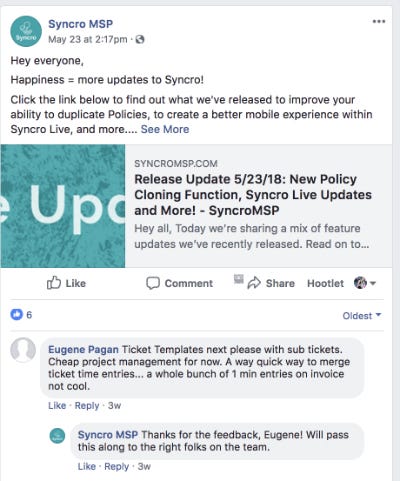Partners aren't the only ones struggling to move from break-fix to managed services. Ian Alexander of SyncroMSP explains how vendors struggle with channel evolution too.

Last year, the channel gained another player in the professional services automation (PSA) and remote monitoring and management (RMM) space. SyncroMSP was born out of the evolution of mainstream partners morphing from value-added resellers (VARs) making money from break-fix to managed service providers (MSPs), which rely on ongoing services and recurring revenue to bring in profit. To CEO Ian Alexander, it was a no-brainer.
Alexander already had a couple of successful products that were originally geared more toward VARs, but developed lightweight PSA and RMM functionalities out of necessity along the way. RepairShopr started as a strict repair provider. Sure, they repaired hardware for the IT sector, but they also repaired cellphones, motorcycles, chainsaws — as Alexander puts it, it was a business in a box for break-fix shops. Which meant that it was essentially a PSA-lite.
Then there was RepairTech, which has a similar story. You could technically call it an RMM, but again, it was RMM-lite. That made it a great starting point for VARs embarking on their journey to becoming MSPs, but these partners would quickly realize the platform wasn’t really designed to support true managed services, and they would graduate to a more powerful, feature-dense offering.
Alexander watched the channel move from primarily VARs to overwhelmingly MSPs almost overnight, but knew that, while shrinking, the resale market wasn’t going to disappear anytime soon. According to preliminary data from the Channel Futures’ 2018 MSP 501 survey, a full 94 percent of respondents identified themselves as MSPs, while VAR solutions provider still came in at a respectable 13 percent. This indicates there are also a big chunk of resellers that offer some sort of basic managed services such as managed firewalls or managed print, but still consider themselves primarily VARs.
Alexander had two choices: Keep the platform as is and lose resale partners as they transitioned into managed services, or add more powerful features to his existing offerings and essentially abandon his break-fix partners. Neither was acceptable.
Creating SyncroMSP and integrating both products into one solution enabled Alexander to solve both of those problems. His team built a more powerful RMM along with the more robust PSA people had been asking for for years, combining them into one platform with its own in-house remote session tool.
One of Alexander’s most likable character traits is that he knows what he doesn’t know, and freely admits it. In a way, the creation of Syncro represents not only the evolution of the channel, but the evolution of Alexander himself, who created a successful business based on traditional break-fix services and then realized somewhere along the way that in order to compete, he had to move into managed services, just like his customers.
His primary method of self-education is engaging partners and testing a slew of new features on an almost daily basis based on user feedback. There’s a Facebook group, several Reddit threads and internal partner forums where MSPs can weigh in on new features and the expansion of the platform, which impresses many partners who engage in social-media outlets.
“I have been giving them a thorough testing the last couple of weeks at syncromsp.com. Scripting my ass off and testing their tech support,” says one Reddit user. “Found them to be extremely responsive and helpful and very responsive to emails. There is also [a] FB group building up as well.”
The platform isn’t as slick as other PSA/RMM offerings, to be sure. It seems to be the No. 1 complaint of Syncro users on social media, which Ian personally responds to. In order to release new features as frequently as Syncro does, they often are more of a beta test of sorts rather than a fully developed, smoothly integrated tool.
“There’s A LOT of settings and customizations but they’re all over the place, will take a beer or six to figure it all out,” complained one user.

But the forums have an ancillary benefit apart from guiding the evolution of the product. Partners talk among themselves, offering help to one another, tips for leveraging the offerings and warnings about other providers.
Alexander is careful not to speak ill of his competitors, but he did address Syncro’s agility as compared to longtime providers, which many partners complain are “exceptionally slow to work with on a daily basis,” according to one user of ConnectWise, which is far and away the industry leader. More than 58 percent of MSP 501 respondents say they utilize ConnectWise — more than twice the second-place winner, SolarWinds.
Alexander attributes that to Syncro’s lack of venture funding. The company has to answer to no one except its partners, and so avoids basing innovation on creating profit to satisfy investors instead of customers.
The consensus seems to be that while Syncro’s PSA makes the grade, its RMM still needs some work. But users express confidence that it won’t take long for that functionality to come up to par, especially with the constant solicitation of feedback from partners that Syncro actually uses to shape its products and integrations.
Syncro is only about seven months old, so no doubt we’ll see the platform mature quickly. While being nimble and responsive is great, there’s something to be said for taking your time to ensure features integrate not only with each other, but with offerings from other vendors. Other, larger PSA/RMM providers are focusing a lot of R&D and messaging to tout their integration capabilities, with good results as MSPs look for ways to save time. As agile as SyncroMSP’s platforms are, it and its partners are still working out the kinks and finding their rhythm within the system.
It’s a crowded marketplace, but Syncro already has profits from RepairTech and RepairShopr to float it, something Alexander says will give the company a leg up because it isn’t trying to appease investors or shareholders.
“We are already profitable. We’re not venture-backed because we were bootstrapped,” he says. “Our only incentive is to help our customers and to make better software.”
About the Author(s)
You May Also Like


